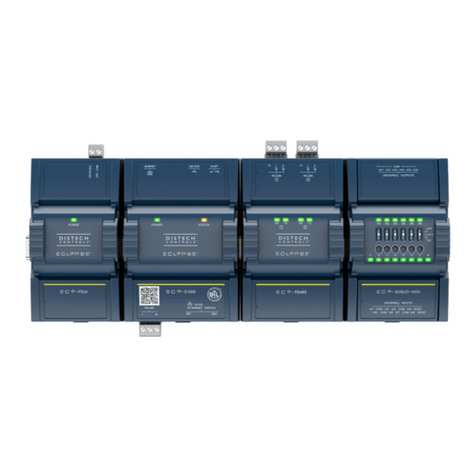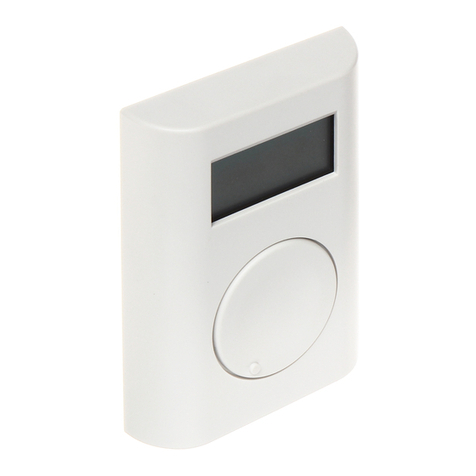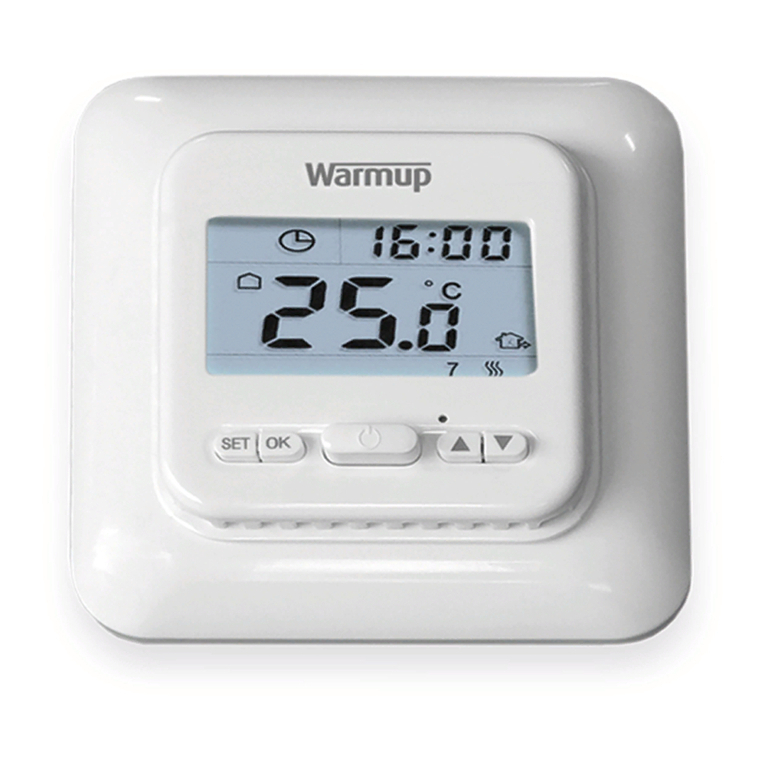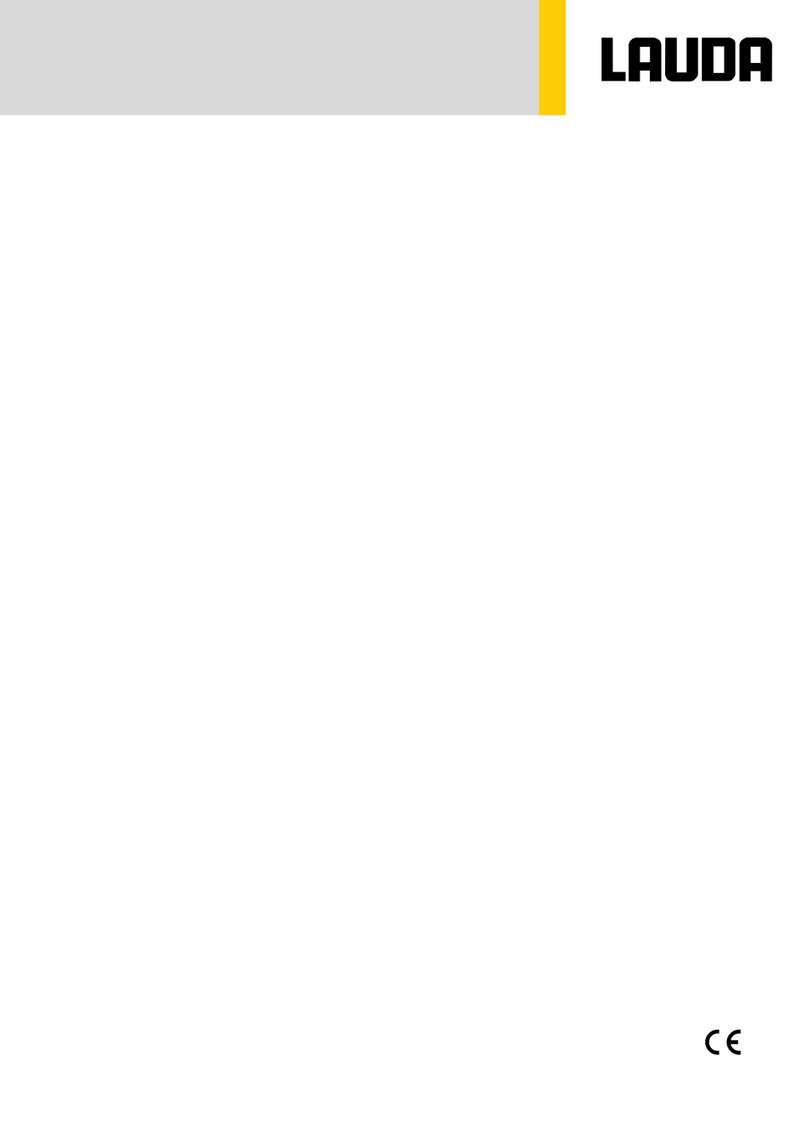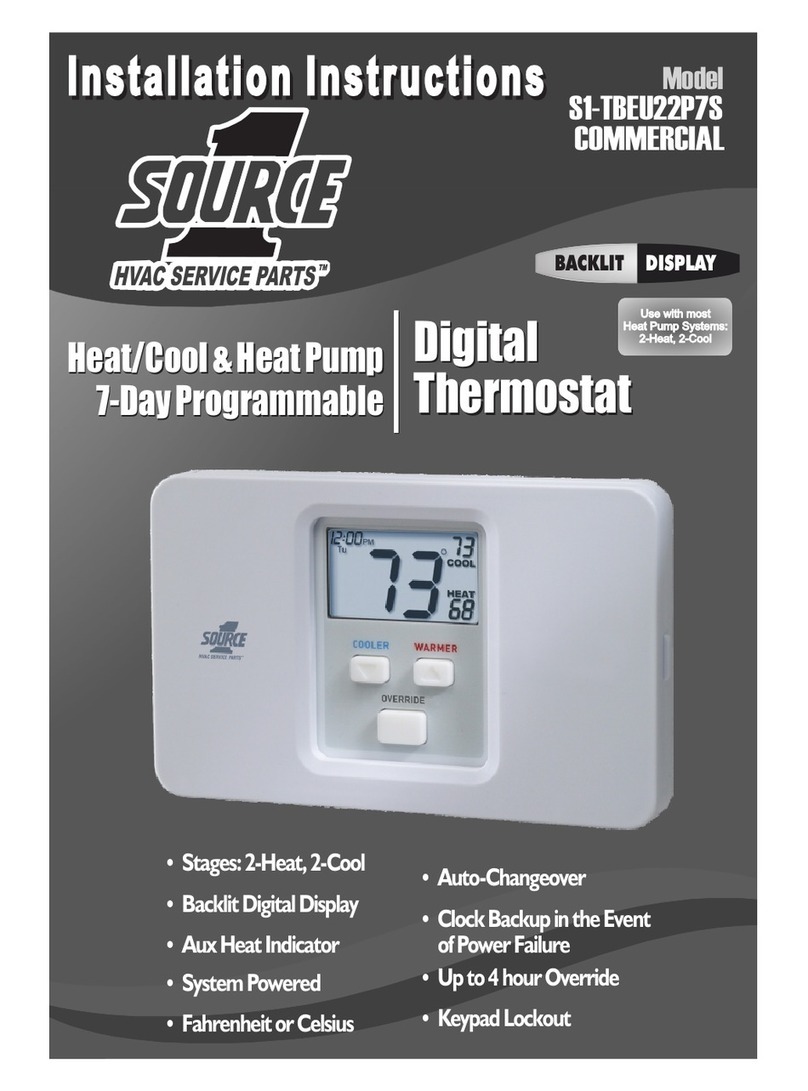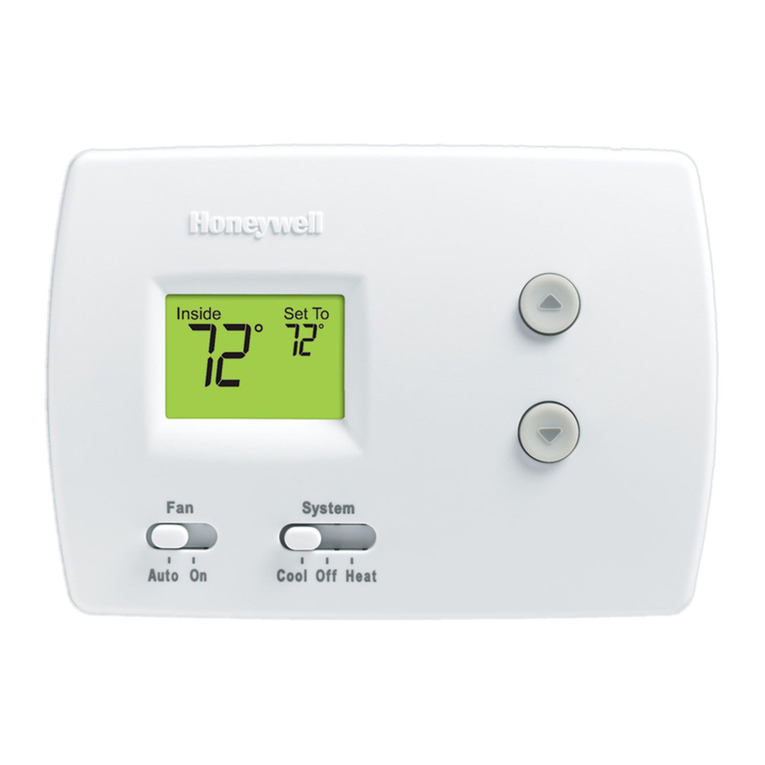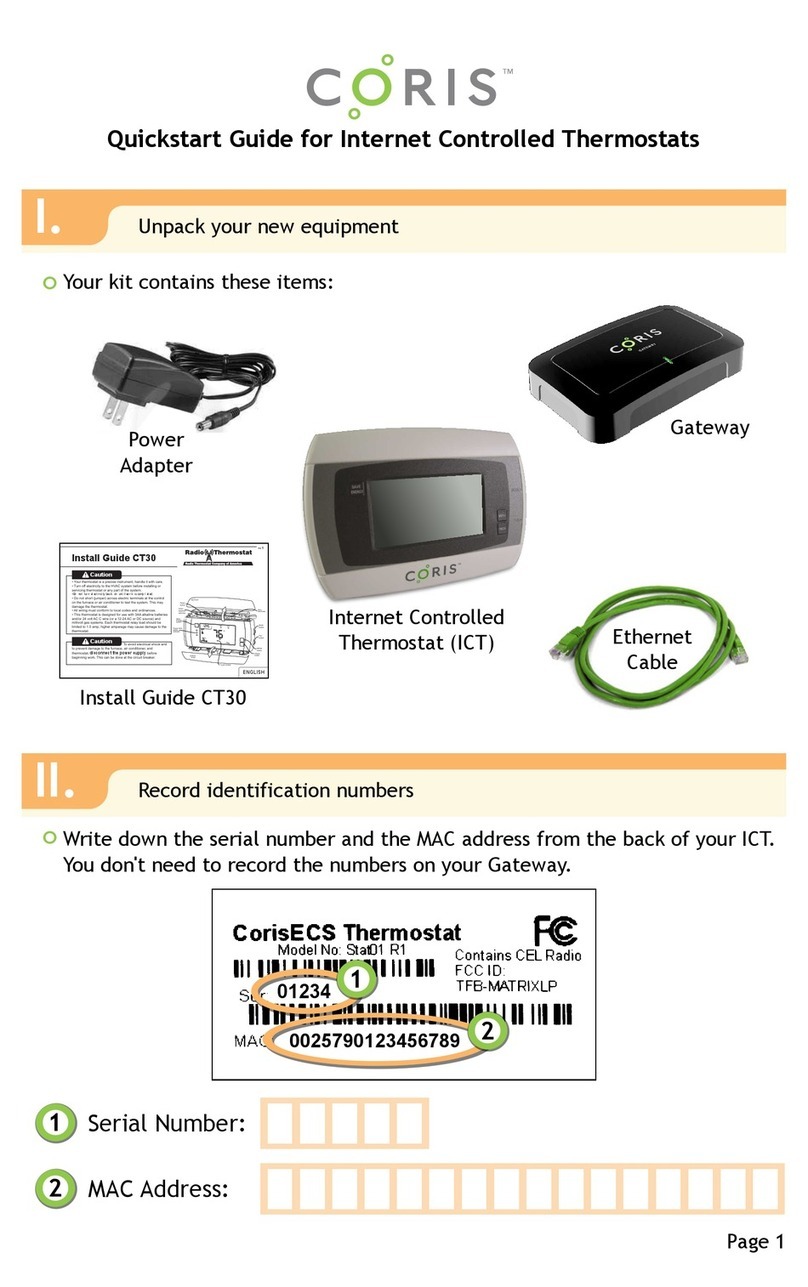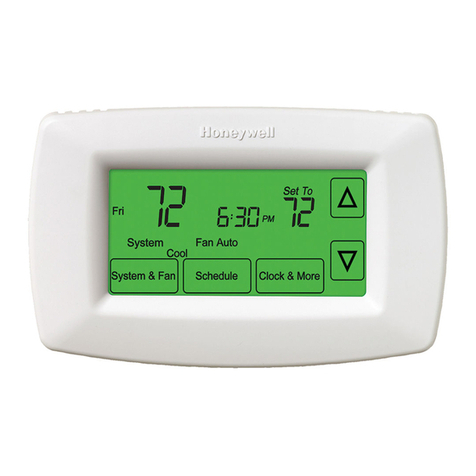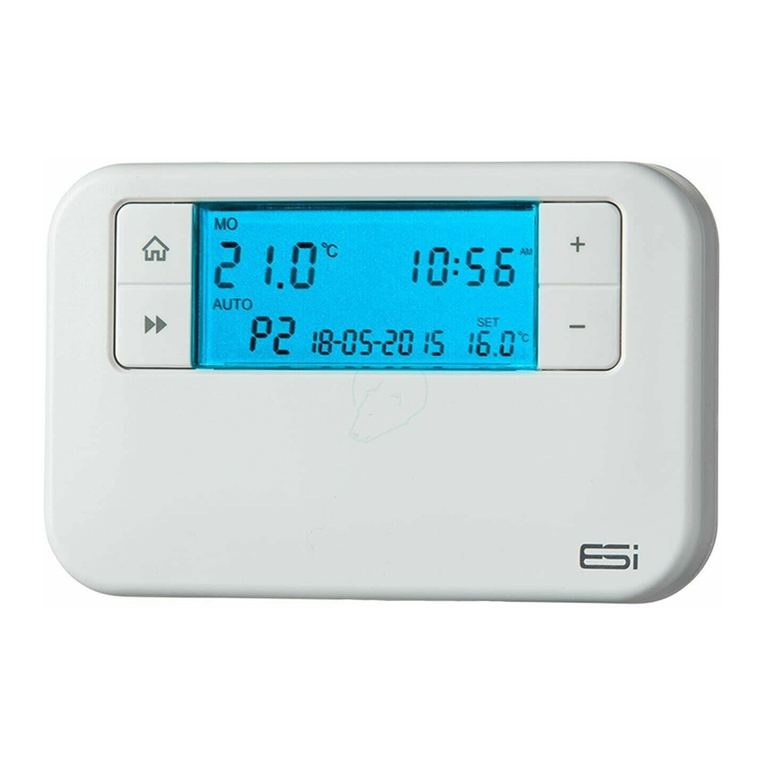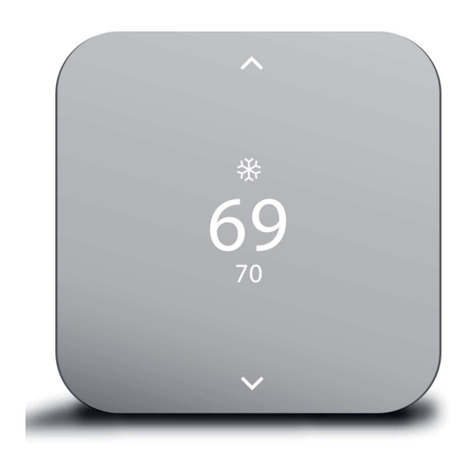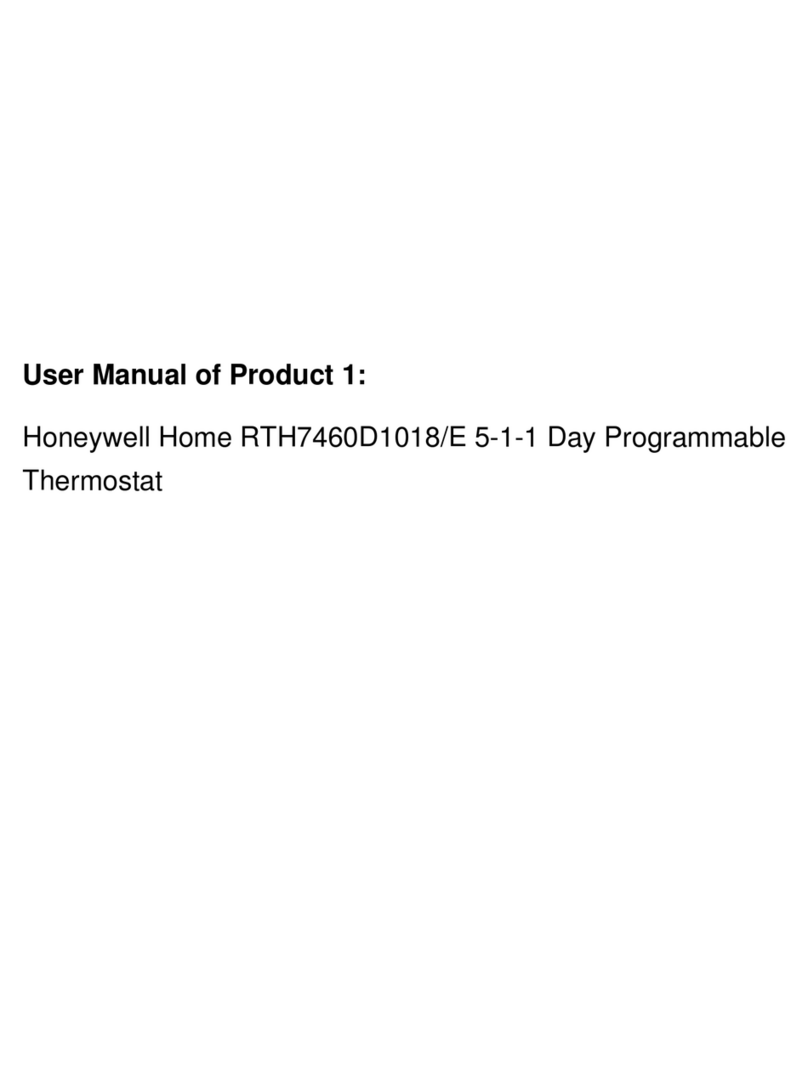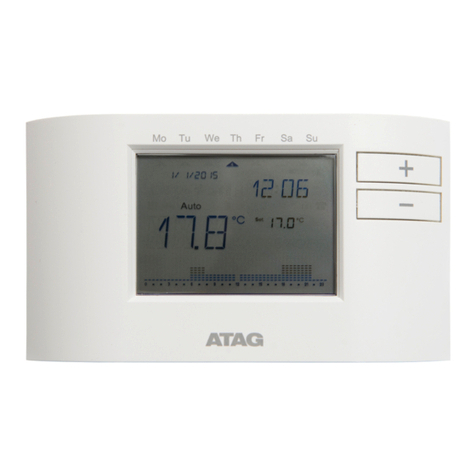Distech Controls RT Series Manual

Hardware Installation Guide
Distech Controls, Inc.
Toll-free: 1-800-404-0043
Tel. International: 450-444-9898
www.distech-controls.com
sales@distech-controls.com
Roof Top (RT) Series: ECL-STAT-RT1P, ECL-STAT-RT2P, ECL-STAT-RT2EP,
ECB-STAT-RT1P, ECB-STAT-RT2P, ECB-STAT-RT2EP,
ECW-STAT-RT1P, ECW-STAT-RT2P, ECW-STAT-RT2EP
Heat Pump (HP) Series: ECL-STAT-HPP, ECB-STAT-HPP, ECW-STAT-HPP
Product overview
The Allure Communicating Roof Top (RT) and Heat Pump (HP) PI thermostat family
is specifically designed for single stage and multi-stage control of heating/cooling
equipment such as rooftop and self-contained units. The product features an intuitive,
menu-driven, back-lit LCD display, which walks users through the programming steps,
making the process extremely simple. Accurate temperature control is achieved due
to the product’s PI time proportional control algorithm, which virtually eliminates
temperature offset associated with traditional, differential-based thermostats.
All models contain two digital inputs, which can be set by the user to monitor filter
status, activate a remote temporary occupancy switch, and/or used as a general
purpose service indicator. In addition, depending on the model, up to three remote
sensor inputs are available. All models contain a SPST auxiliary switch, which can be
used to control lighting or disable the economizer function and a discharge air sensor
-input.
For more advanced applications, economizer control logic has been integrated onto the thermostat for use with proportional damper
economizer actuators.
The thermostats are also compatible with the new Allure Cover accessories. Thermostats equipped with a PIR motion detector cover
provide advanced active occupancy logic, which will automatically switch occupancy levels from Occupied to Unoccupied as required by
local activity being present or not. This advanced occupancy functionality provides advantageous energy savings during occupied hours
without sacrificing occupant comfort. All thermostats can be ordered with or without a factory installed PIR motion detector cover ( see
ordering notes below).
Models available
Application 1 Heat / 1 Cool 2 Heat / 2 Cool 2 Heat / 2 Cool
with economizer
3 Heat / 2 Cool
heat pump
Model (programmable) CDIVI-7652A50(X)1 CDIVI-7652B50(X)1 CDIVI-7656B50(X)1 CDIVI-7652H50(X)1
Ordering Information Notes:
-(X) model number represents available communication options: X=E for LonWorks , X=B for BACnet MS-TP and X=W for Wireless
-The Allure communicating thermostats are delivered with the Allure cover (without PIR motion detector) installed by default.
-If motion detection is required, the appropriate Allure PIR motion detector covers need to be ordered separately and installed in the field.
-However, for minimum order quantities of 50 thermostats (any model), you can have your thermostat with the Allure PIR motion detector cover factory
installed. Lead time of 20 business days. In the Product Number, please replace the 3rd character from the end with a "5" (ex. CDIVI-7600A55E1.)
Features and benefits
Features
Benefits
•Advanced occupancy functions
⇒Through the network or smart local occupancy sensing
•Ready for PIR motion detector accessory cover
⇒Fully integrated advanced occupancy functionality with a PIR
accessory cover
•2 digital inputs
⇒Adds functionality
•Smart fan operation
⇒Saves energy during night mode
•Unique configuration key with password protection
⇒Minimizes parameter tampering
•Lockable keypad
⇒Tamper proof, no need for thermostat guards
•6 hour reserve time for clock
⇒No need to reprogram day/time after power shortage
•Remote room and outdoor temperature sensor
⇒Increase flexibility and functionality
•Auxiliary output
⇒Can be used for lighting and/or economizer override
•Discharge air sensor
⇒Can be used to monitor unit efficiency
•Intuitive, menu-driven programming (7 day, 2/4 events - on
programmable models only)
⇒Can be used for all types of establishments
•Economizer output 0-10 Vdc economizer models only
⇒Excellent retrofit opportunities
•3 Heat/2 Cool (on heat pump models only)
⇒Support single and two stages heat pump with one auxiliary
heat stage
Fig.1

2
Theory of operation
The Allure communicating thermostats use a proprietary adaptive
logic algorithm to control the space temperature. This algorithm
controls the heating / air conditioning system to minimize overshoot
while still providing comfort. It provides exceptional accuracy due to
its unique PI time proportioning control algorithm, which virtually
eliminates temperature offset associated with traditional,
differential-based on/off thermostats.
Fig.2 - On/Off mechanical control vs PI electronic control.
Features overview
•7 day programmable models, 2 or 4 events
•Gas/oil or electric system compatibility for all type of
applications
•Remote indoor averaging sensing capability
•Temperature averaging
•Remote outdoor sensing capability for added flexibility
- System mode lock out
- Heat pump balance point settings
•Remote discharge air sensor input for monitoring purpose
- System efficiency feedback
•Lockable keypads for tamper proofing. No need for thermostat
guards
•Automatic frost protection to prevents costly freeze damage
•Anti short cycle and minimum on/off run time protection.
Reduces wear and maximizes life span of mechanical
equipment.
•2 programmable digital inputs for added flexibility. Each input
can be programmed as the following:
- None: No function will be associated with the input
- Service: a backlit flashing Service alarm will be displayed on
the thermostat LCD screen when the input is energized. It
can be tied in to the AC unit control card, which provides an
alarm in case of malfunction.
- Filter: a backlit flashing Filter alarm will be displayed on the
thermostat LCD screen when the input is energized. It can be
tied to a differential pressure switch that monitor filters
- Rem NSB: remote NSB timer clock input. Will disable the
internal scheduling of the thermostat. The scheduling will now
be set as per the digital input. The menu part related to
scheduling is disabled and no longer accessible. It provides low
cost setback operation via occupancy sensor or from a dry
contact
- RemOVR: temporary occupancy contact. Disables all override
menu function of the thermostat. . The override function is now
controlled by a manual remote momentarily closed contact.
When configured in this mode, the input operates in a toggle
mode.
With this function enabled it is now possible to toggle between
unoccupied & occupied setpoints for the amount of time set by
parameter (TOccTime) temporary occupancy time.
-Fan lock: used in conjunction with a local air flow sensor
connected to the input. Locks out the thermostat heating and
cooling action and displays a local alarm if no air flow is
detected 10 seconds after the fan ( G terminal ) is energized.
•Programmable smart fan operation saves energy during
night mode
•Non volatile EEPROM memory prevents loss of parameters
during power shortage
•Built in default profile set-up for easier start up and
commissioning
•Configurable SPST output relay on programmable models
for lighting, exhaust fan or fresh air control
•6 hour typical reserve time for clock in case of power loss
•0 to 10 Vdc economizer output for more retrofit opportunities
- Built in dry bulb economizer logic using outdoor
temperature sensor
- Input for supply/mixed air temperature sensor
Heat pump model specific features
•Selectable single or dual stage compressor stages
•High balance point:
Locks out auxiliary heating when outside air temperature is
above this value
•Low balance point:
Locks out heat pump compressor operation when outside air
temperature is below this value
•Comfort/economy mode:
In economy mode, heat pump use is maximized before
turning On auxiliary heating
•Compressor/auxiliary interlock:
Adds flexibility by locking out heat pump operation during
auxiliary heating to prevent high pressure trip when the coil
is downstream of the auxiliary heat source.
Fig.2

3
Installation
•Remove security screw on the bottom of thermostat cover.
•Open up by pulling on the bottom side of thermostat.
•Remove Assembly and remove wiring terminals from sticker. (Fig. 3)
•Please note the FCC ID and IC label installed in the cover upon removal of cover
for the wireless products.
A) Location:
1- Should not be installed on an outside wall.
2- Must be installed away from any heat source.
3- Should not be installed near an air discharge grill.
4- Should not be affected by direct sun radiation.
5- Nothing must restrain vertical air circulation to the thermostat.
B) Installation:
1- Swing open the thermostat PCB to the left by pressing the PCB locking tabs.
(Fig. 4)
2- Pull out cables 6” out of the wall.
3- Wall surface must be flat and clean.
4- Insert cable in the central hole of the base.
5- Align the base and mark the location of the two mounting holes on the wall.
Install proper side of base up.
6- Install anchors in the wall.
7- Insert screws in mounting holes on each side of the base.
(Fig. 4)
8- Gently swing back the circuit board on the base and push on it until the tabs lock
it.
10- Strip each wire 1/4 inch.
11- Insert each wire according to wiring diagram.
13- Gently push back into hole excess wring (Fig. 5)
14- Re-Install wiring terminals in correct location. (Fig. 5)
15- Reinstall the cover (top side first) and gently push back extra wire length into the
hole in the wall.
16- Install security screw.
•If replacing an old thermostat, label the wires before removal of
the old thermostat.
•Electronic controls are static sensitive devices. Discharge
yourself properly before manipulation and installing the
thermostat.
•Short circuit or wrong wiring may permanently damage the
thermostat or the equipment.
•Anti-short cycling can be set to 0 minutes for equipment that
posses their own anti cycling timer. Do not use that value
unless the equipment is equipped with such internal timer.
Failure to do so can damage the equipment.
•All Allure communicating thermostats are to be used only as
operating controls. Whenever a control failure could lead to
personal injury and/or loss of property, it becomes the
responsibility of the user to add safety devices and/or alarm
system to protect against such catastrophic failures.
Location of PCB retaining tabs
Re-install terminal blocks
Thermostat assembly
Fig.6
Fig.3
Fig.5
Fig.4

4
Wiring identification & screw terminal arrangement
Multistage
1H / 1C
Heat Pump
Product Name
STAT-RT2EP
STAT-RT2P
STAT-RT1P
Product Name
STAT-HPP
Programmable
Yes
Yes
Yes
Programmable
Yes
Top left terminal block
Top left terminal block
Y2
X
X
Y2
X
Y1
X
X
X
Y1
X
G
X
X
X
G
X
RC
X
X
X
RC
X
C
X
X
X
C
X
Top right terminal block
Top right terminal block
RH
X
X
X
RH
X
W1
X
X
X
W1
X
W2
X
X
O/B
X
Bottom terminal block
Bottom terminal block
Econo
X
Aux
X
X
X
Aux
X
DI1
X
X
X
DI1
X
DI2
X
X
X
DI2
X
RS
X
X
X
RS
X
Scom
X
X
X
Scom
X
OS
X
X
X
OS
X
MS
X
X
X
MS
X
Screw terminal arrangement
Wiring notes:
Note 1: If the same power source is used for the heating stages, install jumper across RC & RH. Maximum current is 2.0 amps.
Note 2: If auxiliary output is used to toggle occupancy of the electronic control card inside the equipment, configure the relay parameter
(Aux cont ) to the N.O. setting. A second relay can be added for additional functionality of the occupancy output.
Note 3: Economizer output uses a half bridge rectifier. Reference of the control signal is the common of the power supply of the
thermostat. (terminal C)
Note 4: Electromechanical contacts are to be used with the digital inputs. Electronic triacs cannot be used as mean of switching for the
input. The switched leg to the input for the input to activate is terminal C ( common )
Note 5: The transformer of the unit provides power to the thermostat and the additional loads that will be wired to the thermostat.
EC
AU
D1
D2
RS
Scom
OS
MS
Y2
Y1
G
RC
C
RH
W1
W2
O/B
5 pole left top connector
3 pole left top connector
8 pole bottom connector
Fig.7

5
Detailed wiring diagrams for selected models
CDIVI-7656B5XE1
2 Heat / 2 Cool / Economizer / Programmable
Heat
Stage 2
Cool
Stage 1
System wiring
Thermostat internal wiring
Jumper J1 T1
24 Vac
Cool
Stage 2
Y2 Y1
Jumper J1
See note 1
(previous
page)
Fan
RCG C
Heat
Stage 1
W1RH W2
Auxiliary
Output
Field contacts
Com24V
Remote
Outdoor
Sensor
Digital Input #2
Digital Input #1
Remote
Room
Sensor
0-10 Vdc
EC AU DI1 DI2 RS
Remote
Mixed Air
Sensor
MSScom OS
CDIVI-7652H5XE1
Heat pump / Programmable
Auxiliary
Heat
W1
System wiring
Jumper J1
Thermostat internal wiring
Compressor
Stage 1
24 Vac
T1
Compressor
Stage 2
Y2
Jumper J1
See note 1
(previous
page)
Fan
G
Y1
RC
C
RH
Remote
Room
Sensor
Field contacts
Reversing
Valve
Digital Input #2
Digital Input #1
Auxiliary
Output
O/B
AU
DI1
DI2
Scom
RS
Remote
Outdoor
Sensor
Remote
Mixed Air
Sensor
MS
OS
Thermostat Terminals -
STAT-HPP
Y2
DI1
DI2
AU
Y1
RC
G
O/B
OS
RS
Scom
RH
C
W1
MS
Thermostat Terminals -
STAT-RT2EP
Y2
EC
RC
G
Y1
AU
DI1
DI2
W2
MS
W1
RH
C
Scom
RS
OS

6
Remote sensor accessories
Model no.
Description
PDITE-SENSORX0
Wall mounted temperature sensor
PDITE-SENSOROX0
Wall mounted temperature sensor w/ override button and occupancy status LED
PDIGR-TE200F Series
Outdoor temperature sensor
PDIGR-TE200D Series
Averaging temperature sensor
PDIGR-TE200B Series
Duct mounted temperature sensor
PDITE-SENSOROX0, remote wall mount temperature sensors use 10K NTC thermistors.
This sensor can be used for:
•Various averaging combinations
•Optional occupancy led
•Optional override key
Fig.8 –
PDITE-SENSOROX0
PDIGR-TE200B SERIES, remote duct mounted temperature sensor.
This sensor can be used for:
•Remote return air temperature sensing with the sensor mounted on
the return air duct.
•Outside air temperature sensing with the sensor installed in the fresh
air plenum.
•Supply air temperature sensor
Fig.9 – PDITE-TE200B Series (shown with standard
ABS enclosure)
PDIGR-TE200D SERIES, remote averaging duct mounted temperature sensor c/w junction box.
This sensor can be used for:
•Remote averaging return air temperature sensing with the sensor mounted on the return air duct.
•Outside air temperature averaging sensing with the sensor installed in the fresh air plenum.
•Mixed air temperature averaging sensor for economizer models with the sensor in the mixing plenum.
PDIGR-TE200F SERIES, outdoor air temperature sensor
This sensor can be used for:
•Outside air temperature sensing with the sensor installed directly exposed to the elements.
•Sensor uses a weather resistant enclosure for outdoor applications
WIRING PDITE-SENSORX0, PDITE-SENSOROX0, PDIGR-TE200B Series, PDIGR-TE200D Series and PDIGR-TE200F Series
Remote wiring 1 sensor Remote wiring 4 sensors
10 K 10 K 10 K 10 K 10 K
Scom
MS
Scom
OS
Scom
RS or
or Scom
MS
Scom
OS
Scom
RS or
or
(

7
LonWorks Wiring Guide
Overview
For clarity we will use the term “Device” to represent any product with an active LonWorks network
connection, including Distech Controls and non-Distech Controls controllers.
Summary Specifications:
Parameter
Details
Network Wiring
24 to 16AWG, twisted pair
Maximum total wire length
1
1600 feet (500 meters) in free topology
Maximum device-to-device distance
1600 feet (500 meters) in free topology
Polarity
Polarity insensitive
Multi-drop
Free Topology
Termination for Free Topology Network Segment
One RC network with Ra = 52.3Ω±1%, 1/8W
Termination for Doubly Terminated Bus Network
Segment
Two RC network with Ra = 105
Ω
±1%, 1/8W
Number of transceivers per segment
Up to 64
Baud rate
78000 bits per second
1Network segment length varies depending on wire type.
Table 1: Summary of Specifications for a Distech Controls’ LON Network
Network Configuration
The LonWorks network is designed to support free topology wiring and will accommodate bus, star, loop or
any of these topologies. LonWorks devices can be located at any point along the network wiring.
Figures 3.1 to 3.5 present five different network topologies. The actual termination circuit will vary by
application.

8
LonWorks Wiring Guide

9
LonWorks Wiring Guide
Maximum Number Of Devices
Up to 64 transceivers are allowed per network segment. If your network requires more than 64 transceivers a
repeater is then required to extend your network
Maximum Cable Length
The maximum length of a chain is related to its transmission speed. The longer the chain, the slower the
speed. Using proper cable, LonWorks supports a baud rate of 78 kilobits per second for distances up to
1600-ft (500 m) in free topology and 8800 ft (2700 m) in bus topology with double terminations.
If you require a maximum network length of more than 1600-ft (500 m) or 8800 ft (2700 m), then a
repeater is required to extend the network.
Repeater
In the event that the limits on the number of transceivers or total wire distance are exceeded, a physical
layer repeater can be added to interconnect two or more network segments. A repeater will double the
overall channel capability, including node count and network extent, but not bandwidth. Note that only
one physical layer repeater should be placed in series between any two nodes on a channel. If
additional cabling or network bandwidth is required, then a LonWorks Router should be used in place of
a repeater.
Terminators
LonWorks network segments requires termination for proper data transmission performance. The type of
terminator varies depending on whether shielded or unshielded cable is used. Free topology and Bus
networks also differ in their termination requirements. The following sections describe the various terminators
and terminations procedure.
Free Topology Network Segment
In a free topology segment, only one termination is required and may be placed anywhere on the
free topology segment. There are two choices for the termination:
1. RC network with Ra = 52Ω±1%, 1/8W
2. LPI-10 Link Power Interface, with jumper at “1 CPLR” setting.
Doubly Terminated Network Segment
In a doubly terminated bus topology, two terminations are required, one at each en of the bus.
There are two choices for each termination:
1. RC network with Ra = 105Ω±1%, 1/8W
2. LPI-10 Link Power Interface, with jumper at “2 CPLR” setting.
Only one LPI-10 interface is supported per segment. The other terminator must be an RC-type.
LonWorks Wiring Guide

10
Grounding Shielded Twisted Pair Cable
When using Shielded Twisted Pair, terminate the twisted pair as listed in the previous section and
ground the cable shield by using a capacitor, to tie the shield to earth ground, and a large-value
resistor to bleed off any static charge on the shield. Tying the shield to earth ground through a
capacitor will avoid DC and 50/60Hz ground paths from being formed through the shield. Typical
values for resistor and capacitor are as follows:
Capacitor = 0.1µF, 10%, Metalized Polyester, ≥100V
Resistor = 470kΩ, 1/4W, ±5%
The cable shield should be grounded at least once per segment, and preferably at each node.
Grounding the shield at every node will assist in suppressing 50/60Hz standing waves.
Network adapter
Although network connections are polarity insensitive, it is good practice to keep polarity consistent
throughout the entire site. Figure 4 shows a network connection example and the location of the Status LED.
This Status LED may help to troubleshoot network problems.
Figure 4: Network connections and location of the Status LED on a LON module
Table 2 shows the different possibilities with the Status LED behaviour of the LON module.
Condition of the Status LED
Explanation
Continuously ON
The device has no application loaded in its memory and is
Un-configured
Flashing at a rate of 1/2Hz
The device has an application loaded in its memory but is Un-
configured. When a device is in the un-configured state, it
does not know which devices to communicate with. A network
management tool is used to logically bind the node to another
in a LonWorks network.
Continuously OFF
The device has an application loaded into its memory and is
bound onto a LonWorks network.
Table 2: Status LED condition

11
BACnet Wiring Guide
Overview
Distech Controls uses EIA-485 as the physical layer between their devices and supervisory controllers
For clarity we will use the term “Device” to represent any product with an active EIA-485 network
connection, including Distech Controls and non-Distech Controls controllers.
Summary Specifications:
Parameter
Details
Media
Twisted pair 22AWG-24 AWG, shielded recommended
Characteristic Impedance
100-130 ohms
Distributed capacitance
Less than 100 pF per meter (30 pF per foot)
Maximum length per segment
1200 meters (4000 feet) Note: AWG 18 cable
Polarity
Polarity sensitive
Multi-drop
Daisy-chain (no T connections)
Terminations
1. Distech Controls’ thermostats are installed at both
ends of the MSTP network:
120 Ohms resistor should be installed at each end.
2. A Distech Controls thermostat is installed at one end of
the MSTP network and a 3rd party device is installed at
the other end:
Install an End-Of-Line resistor value that matches the 3 rd
party device instruction regarding the End-Of-Line resistors
3. 3rd party devices are installed at both ends of the MSTP
network:
Follow the 3rd party device instructions regarding the End-
Of-Line resistors.
Network Bias Resistors
510 ohms per wire (max. of two sets per segment)
Maximum number of nodes per
segment
64 (Distech Controls devices only)
Maximum number of nodes per
network
128
Baud rate
9600, 19200, 38400, 76800 (Auto detect)
Table 1: Summary of Specifications for a Distech Controls’ EIA-485 Network

12
BACnet Wiring Guide
Cable Type
Distech Controls recommends the use of balanced 22-24 AWG twisted pair with a characteristic impedance
of 100-130 ohms, capacitance of 30 pF/ft or lower. A braided shield is also recommended.
Impedance
A value based on the inherent conductance, resistance, capacitance and inductance that represent the
impedance of an infinitely long cable. The nominal impedance of the cable should be between 100Ωand
120Ω. However using120Ω will result in a lighter load on the network.
Capacitance (pF/ft)
The amount of equivalent capacitive load of the cable, typically listed in a per foot basis. One of the factors
limiting total cable length is the capacitive load. Systems with long lengths benefit from using low capacitance
cable (i.e. 17pF/ft or lower).
Network Configuration
EIA-485 networks use a daisy chain configuration. A daisy chain means that there is only one main cable
and every network device is connected directly along its path.
Figure 3 illustrates two improper network configurations and the proper daisy chain configuration.
Other methods of wiring an EIA-485 network may give unreliable and unpredictable results. There are no
troubleshooting methods for these types of networks. Therefore, a great deal of site experimentation may
have to be done, making this a difficult task with no guarantee of success. Distech Controls will only support
daisy chain configurations.
Figure 3: Three different network configurations: star, bus, and daisy chain. Only
the daisy chain configuration is correct for an EIA-485 network.

13
BACnet Wiring Guide
Maximum Number of Devices
A maximum of 64 nodes is allowed on a single daisy chain segment. A node is defined as any device (Panel,
Zone, Repeater, etc) connected to the RS485 network. Terminators do not count as a node.
To determine the number of nodes on a network, add the following:
One node for each device, including main panels
One node for each repeater on the chain
For the example in Figure 4, we have one node for the main Panel, plus 4 for the controllers, for a total of 5
nodes.
Figure 4: Five nodes network example.
If you have more than 64 devices, then repeaters are required to extend the network.
Maximum Cable Length
The maximum length of a chain is related to its transmission speed. The longer the chain, the slower the
speed. Using proper cable, the maximum length of an EIA-485 daisy chain is 4000-ft (1200 m). This will
only work reliably for data rates up to 100,000 bps. Distech Controls’ maximum data rate is 76,800 bps.
If you require a maximum network length of more than 4000 feet, then repeaters are required to extend
the network.
EIA-485 Repeaters
If you have more than 64 devices, or require a maximum network length of more than 4000 feet, then
repeaters are required to extend the network. The best configuration is to daisy chain the repeaters to
the main panel. From each of these repeaters, a separate daisy chain will branch off. Figure 5
demonstrates a valid use of repeaters in an EIA-485 network.

14
BACnet Wiring Guide
Figure 5: Correct usage – repeaters are daisy chained to the supervisory
controller and separate daisy chains branch from each repeater.
Do not install repeaters in series, as this may result in network reliability problems. Figure 6 demonstrates an
incorrect use of a repeater in an EIA-485 network.
Figure 6: Incorrect usage – the second repeater in series may result in
an unreliable system

15
BACnet Wiring Guide
End Of Line (EOL) Resistors
MS/TP network must be properly terminated. For daisy chain configurations, you must install an EOL resistor
at each end of the daisy chain. Depending on your MSTP network configuration, the resistance value of the
EOL resistor may change:
•Distech Controls thermostats are installed at both ends of the MSTP network:
120 Ohms resistor should be installed at each end.
•A Distech Controls thermostat is installed at one end of the MSTP network and a 3rd party
device is installed at the other end:
Install an End-Of-Line resistor value that matches the 3rd party devices instructions regarding its
EOL resistor value;
•3rd party devices are installed at both ends of the MSTP network:
Follow the 3rd party devices instructions regarding its EOL resistor value.
Network Adapter
The polarity of the connection to the cable is important. From one module to the other it is important that the
same colored wire be connected to “plus” or “+” and the other colored wire be connected to the “minus” or ”-
“. Figures 7 shows the proper MS/TP connections and the location of the Status LED. This Status LED may
help to troubleshoot network problems.
Figure 7: Correct MS/TP connections and location of a Status LED on a BACnet module
IMPORTANT NOTE: The Ref terminal should NEVER be used to wire shields. The 2 shields from each feed
of the network connection to a thermostat should be wired together in the back of the thermostat and properly
protected to prevent any accidental connection to the ground.
The joined shield connection should then be grounded at a SINGLE point on the whole segment. More than
one ground connection to a shielded wire may induce ground loop noises and affect communication.
Table 2 shows the different possibilities with the Status LED behaviour for a BACnet module.

16
BACnet Wiring Guide
Condition of the Status LED
Possible Cause
Solution
BACnet communication NOT active
at default MAC address = 254
Change MAC address to
another value from 0 to 127
1 short blink
Incorrect module has been
installed
Incorrect module has been
installed
2 short blink (no wires
connected to the module) The right module has been installed
on the right thermostat model N/A
2 short blink (wires
connected to the module) Module is not at the same baud rate
as the network
Power off and on the
thermostat
2 short blinks and a longer
blink (wires connected to
the module)
The module has detected the
presence of a network N/A
Right after power is
applied: 2 long blinks and
then no blinking
Polarity has been reversed at the
module
Reverse polarity at the
module
Table 2: Status LED condition and possible solutions

17
User menu flow chart:
Schedule
set? Y/N
Sys mode
set? Y/N
Clock
set? Y/N
Temperat
set? Y/N
Schedule
hold Y/N
Exit
menu Y/N
Unocc HT
set? Y/N
°F/°C
set? Y/N
Heating
set? Y/N
Unocc CL
set? Y/N
Cooling
set? Y/N
°C
°F
Exit?
Y/N
Temperature
Temperature
Temperature
Temperature
MENU
12/24hrs
set? Y/N
12 / 24
Time
set? Y/N
Time
Day
set? Y/N
Day
Fan mode
set? Y/N
On
Smart
Auto
Sunday
set? Y/N
Saturday
set? Y/N
Friday
set? Y/N
Thursday
set? Y/N
Wednesda
set? Y/N
Tuesday
set? Y/N
Monday
set? Y/N
Exit?
Y/N
Occupied
day? Y/N
Occupied
12:00 pm
Time
Unoccup
12:00 pm
Time
Occupied
day? Y/N
Occupied
12:00 pm
Time
Unoccup
12:00 pm
Time
Occupied
day? Y/N
Occupied
12:00 pm
Time
Unoccup
12:00 pm
Time
Occupied
day? Y/N
Occupied
12:00 pm
Time
Unoccup
12:00 pm
Time
Occupied
day? Y/N
Occupied
12:00 pm
Time
Unoccup
12:00 pm
Time
Occupied
day? Y/N
Occupied
12:00 pm
Time
Unoccup
12:00 pm
Time
Occupied
day? Y/N
Occupied
12:00 pm
Time
Unoccup
12:00 pm
Time
Resume
Occ Hold
Uno Hold
Exit?
Y/N
off
emergenc
heat
cool
auto
Override
schd Y/N
Cancel
ovrd Y/N
If status is:
Unoccupied
If status is:
Temporary Occupied Time,

18
Programming and status display instructions
1. Status display
The thermostat features a two-line, eight-character display. There is a low level back-light level that is always active and can only be
seen at night. When left unattended, the thermostat has an auto scrolling display that shows the actual status of the system. Each
item is scrolled one by one with the back lighting off. Pressing any key will cause the back light to come on.
Sequence of auto-scroll status display:
Room
temperature
Clock status
System mode
Schedule status
Outdoor
temperature
Alarms
RoomTemp
Monday
Sys mode
Occupied
Outdoor
Service
x.x °C or °F
12.00 AM
auto
x.x °C or°F
Sys mode
off
Occupied
hold
Frost ON
Sys mode
heat
Unoccup
SetClock
Sys mode
cool
Unoccup
hold
Filter
Sys mode emergenc
Override
Fan lock
Manual scroll of each menu item is achieved by pressing the Yes ( scroll ) key repetitively. The last item viewed will be shown on the
display for 30 seconds before returning to automatic scrolling. Temperature is automatically updated when scrolling is held.
Outdoor air temperature display is only enabled when an outdoor air temperature sensor is connected.
•A maximum range status display of 50 °C ( 122 °F ) indicates a shorted sensor. Associated functions, such as mode lockouts and
economizer function are automatically disabled.
•A minimum range status -40 °C ( -40 °F ) is not displayed and indicates an opened sensor or a sensor not connected. Associated
functions, such as mode lockouts and economizer function are automatically disabled.
If alarms are detected, they will automatically be displayed at the end of the status display scroll. During an alarm message display,
the back lit screen will light up at the same time as the message and shut off during the rest of the status display. Two alarms
maximum can appear at any given time. The priority for the alarms is as follows:
Frost ON
Indicates that the heating is energized by the low limit frost protection room temperature setpoint 5.6 °C ( 42 °F )
SetClock
Indicates that the clock needs to be reset. There has been a power failure which has lasted longer than 6 hours
Service
Indicates that there is a service alarm as per one of the programmable digital input ( DI1 or DI2 )
Filter
Indicates that the filters are dirty as per one of the programmable digital input ( DI1 or DI2 )
Fan lock
Indicates that the heating and cooling action are locked out due to a defective fan operation
Three status LEDs on the thermostat cover are used to indicate the status of the fan, a call for heat, or a call for cooling.
LED
operation
Heatpump models CDIVI-76xxH
Multistage and single stage models
CDIVI-7652A & CDIVI-7652B
Multistage economizer models
CDIVI-7656B
Fan LED on
When G Fan terminal operates
When G Fan terminal operates
When G Fan terminal operates
Heating LED
on
When Y1 and / or W1 terminal(s)
operate in heating mode
When W1 terminal operate in heating
mode
When W1 terminal operate in heating
mode
Cooling LED
on
When Y1 terminal operate in cooling
mode
When Y1 terminal operate in cooling
mode
When Y1 terminal operate in cooling
mode and or economizer output is in
function
Fig.10 – Heatpump, multistage and single stage models

19
2. User programming instructions menu
The Allure communicating thermostats feature an intuitive, menu-driven, back-lit LCD display that walks users through the programming steps,
making the programming process extremely simple. This menu is typically accessed by the user to set the parameters such as temperature and
time events, system mode, fan mode, etc.
It is possible to bring up the user menu at any time by depressing the MENU key. The status display automatically resumes after exiting the user-
programming menu.
If the user pauses at any given time during programming, Auto Help text is displayed to help and guide the user through the usage and
programming of the thermostat.
Ex.:
Press yes key to change cooling temperature setpoint
Each of the sections in the menu are accessed and programmed using 5 keys on the thermostat cover.
The priority for the alarms is as follows:
The YES key is used to confirm a selection, to move onto the next menu item and to manually scroll through the displayed
information.
The NO key is used when you do not desire a parameter change, and to advance to the next menu item. Can also be used to
toggle between heating and cooling setpoints.
The MENU key is used to access the Main User Menu or exit the menu.
The down arrow key is used to decrease temperature setpoint and to adjust the desired values when programming and
configuring the thermostat.
The up arrow key is used to increase temperature setpoint and to adjust the desired values when programming and
configuring the thermostat.
When left unattended for 45 seconds, the display will resume automatic status display scrolling.
To turn on the back light, press any key on the front panel. The back lit display will turn off when the thermostat is left unattended for 45 seconds
Sequence of user menu:
Override
Resume
Temperature
setpoints
System mode
setting
Fan mode setting
Schedules setting
Clock setting
Override
schd Y/N
Temperat
set Y/N
Sys mode
set Y/N
Fan mode
set Y/N
Schedule
set Y/N
Clock
set Y/N
Appears only in
unoccupied mode
Cancel
ovrd Y/N
Appears only in
override mode
There is a default profile set in the thermostat from the factory.
This enables the thermostat to operate as a non-programmable unit in day mode operation at start up.
Programmed default temperature setpoints:
Programmed default modes:
Occupied cooling setpoint = 24 °C ( 75 °F )
System mode = Auto
Occupied heating setpoint = 22 °C ( 72 °F )
Fan mode = Smart (for models with a communication module
Unoccupied cooling setpoint = 28 °C ( 82 °F )
Unoccupied heating setpoint = 18 °C ( 65 °F )
Programmed default schedules:
Fahrenheit scale
Monday through Sunday
Setpoint type = permanent
Occupied time is: 12 00 AM
Unoccupied time is: 11:59 PM
There will be a 1 minute unoccupied period every night at 11:59 PM with this default configuration.

20
A) Override an unoccupied period
Override
schd Y/N
This menu will appear only when the thermostat is in unoccupied mode. The unoccupied mode is enabled either by the internal timer scheduling or
by a remote NSB contact via DI1 or DI2.
If DI1 or DI2 is configured to operate as a remote temporary override contact, this menu will be disabled.
Answering yes to this prompt will cause the thermostat to go into occupied mode for an amount of time equal to the parameter “TOccTime” (1 to 12
hours).
B) Resume regular scheduling
Cancel
ovrd Y/N
This menu does not appear in regular operation. It will appear only when the thermostat is in Unoccupied override mode.
Answering “Yes” to this question will cause the thermostat to resume the regular programmed setpoints & scheduling.
C) Temperature setpoints
Permanent setpoint changes
Temperat
set Y/N
This menu permits the adjustment of all permanent temperature setpoints (occupied and unoccupied) as well as the desired temperature units (°F
or °C). Permanent setpoints are written to RAM and EEPROM
Cooling setpoint
Occupied mode
Heating setpoint
Occupied mode
Cooling setpoint
Unoccupied mode
Heating setpoint
Unoccupied mode
°F or °C
display setting
Cooling
set? Y/N
No next →
Yes down
↓
Heating
set? Y/N
No next →
Yes down
↓
Unocc CL
set? Y/N
No next →
Yes down
↓
Unocc HT
set? Y/N
No next →
Yes down
↓
°F or °C
set? Y/N
No next →
Yes down
↓
Use ▲▼ keys to set value, Yes key to confirm
Cooling
70.0 °F
Use ▲▼
To set
value
Heating
68.00 °F
Use ▲▼
To set
value
Unocc CL
80.0 °F
Use ▲▼
To set
value
Unocc HT
60.0 °F
Use ▲▼
To set
value
Units
°F
Use ▲▼
To set
value
Temporary setpoint changes
Temporary setpoints can be modified through the Up arrow key (▲) and the Down arrow keys (▼).
User will be prompted with the present mode (Heating or Cooling) of the thermostat and its setpoint.
The Up (▲) arrow key will increment the setpoint by 0.5 degree (F or C).
The Down (▼) arrow key will decrement the setpoint by 0.5 degree (F or C).
Press the Yes key to accept the new setpoint.
Local changes to the heating or cooling setpoints made by the user directly using the up or down arrow are temporary.
They will remain effective for the duration specified by ToccTime.
Setpoints will revert back to their default value after internal timer ToccTime expires.
If a permanent change to the setpoints is required, use the Temperat set ? menu
D) System mode setting
Sys mode
set Y/N
This menu is accessed to set system mode operation
Use ▲▼ to set value, Yes key to confirm
Sys mode
auto
Automatic mode
Automatic changeover mode between heating and cooling operation
Sys mode
cooling
Cooling mode
Cooling operation mode only
Sys mode
heating
Heating mode
Heating operation mode only
Sys mode
emergency
Emergency heat mode ( heat pump models only )
Forced auxiliary heat operation mode only
Sys mode
off
Off mode Normal cooling or heating operation disabled
If enabled in installer parameters, only the automatic heating frost protection at 50 °F ( 10 °C ) is enabled
This manual suits for next models
13
Table of contents
Other Distech Controls Thermostat manuals
